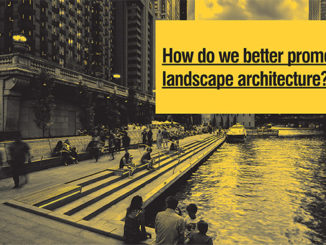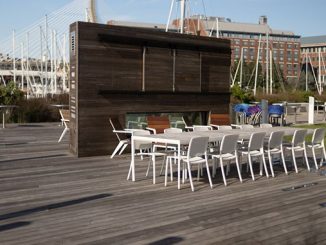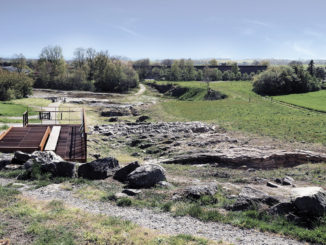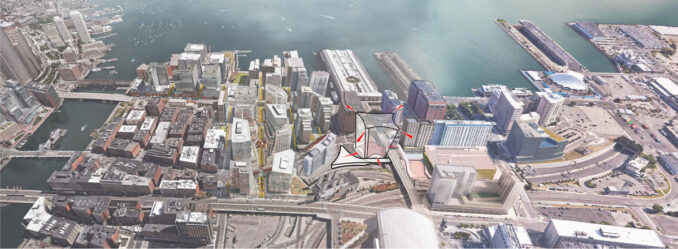
Located in Boston’s Seaport District, 10 World Trade is a new lab and office building sited on one of the city’s most visible and strategic parcels. Halfway between the newly-redeveloped Commonwealth Pier to the north and the Boston Convention and Exhibition Center to the south, the site sits at a critical nexus between two of the area’s busiest destinations. Bound by busy roadways on all sides, the elevated World Trade Center Avenue strategically connects the convention center to the waterfront. Originally envisioned as a transport artery for freight and passenger traffic arriving at Commonwealth Pier, today World Trade Center Avenue is an important pedestrian connector serving the entire Seaport District.
In recent years, mixed-use development has continued to migrate south from the waterfront and along Seaport Boulevard, surrounding the site and thereby making this parcel an important node that offers the potential to link the waterfront to the wider district. Massport, Boston Global Investors’ (BGI) development team and Sasaki have worked together on a vision for a parcel at a critical intersection of connectivity for the area—linking levels, modes of transport, and the public-private realms.
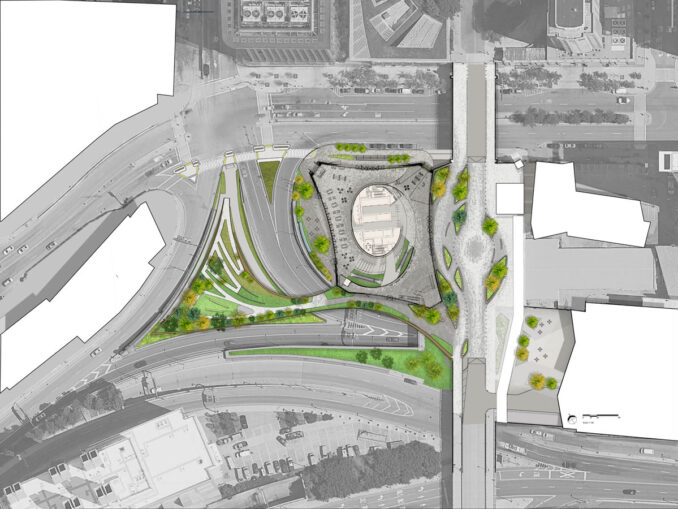
During the project’s early phases, the Sasaki-led design team recognized the unique opportunity to engage in an integrated approach between architecture and landscape to create a destination that prioritizes the public realm and creates an opportunity to reinvigorate the design of movement corridors within the Seaport. The team had to see beyond the typical aesthetic of a glass box sat atop a plaza, instead integrating transitions of interior and exterior spaces into larger site-wide gestures. Through the interplay of hard- and softscape elements, the team envisioned a network of much-needed community open spaces as a singular, unified experience.
This site challenged the Sasaki team to think innovatively about incorporating a grade change of 27 feet (8 meters) from Congress Street to World Trade Center Avenue into a network of public spaces while casting movement corridors as destinations in and of themselves. The team set out to design accessible, welcoming, and unique spaces — in bold juxtaposition to the hardscaped character of the current urban condition.
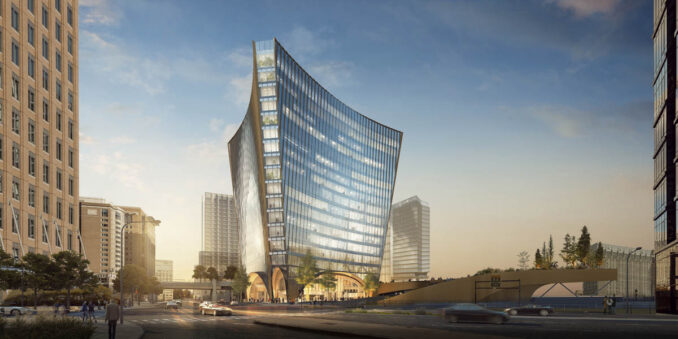
A Multi-faceted Landscape Design Brings Cohesion to a Complex Site
Presented with a unique opportunity as a designer of both the building and the site for the project, Sasaki began the design exercise with the philosophy that the building and landscape should have a symbiotic relationship. From all sides, the design draws people in and invites them into a series of interconnected indoor/outdoor landscapes that blur the boundaries of building and site to cultivate a year-round destination.
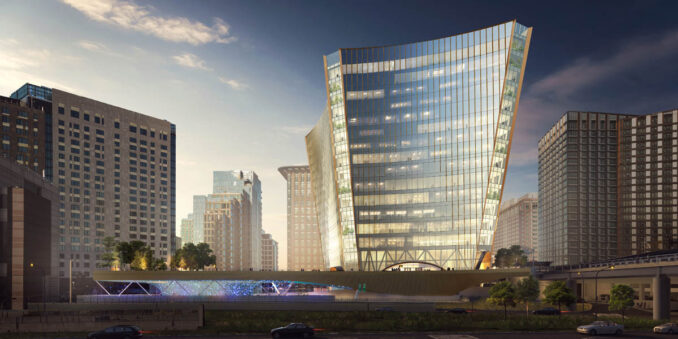
The experience of these spaces unfolds through a series of scales. Viewing the project from afar reveals the unique form of the building, with an emphasis on the push and pull of the facades and corners that brings the base of the building inward and creates a generous public realm on the ground floor. An uninterrupted public plaza flows from the streetscape through the architectural arches into the building on the north and east sides. In juxtaposition, along the south and west, a densely planted landscape wraps the building, creating an unexpected moment of joy and intrigue. Up close, as one approaches the landscape along World Trade Center Avenue, a new public plaza traverses this key pedestrian corridor and flows through to the interior, with the forms of the paving and the landscape emphasizing the unique curvature of the building’s facade.
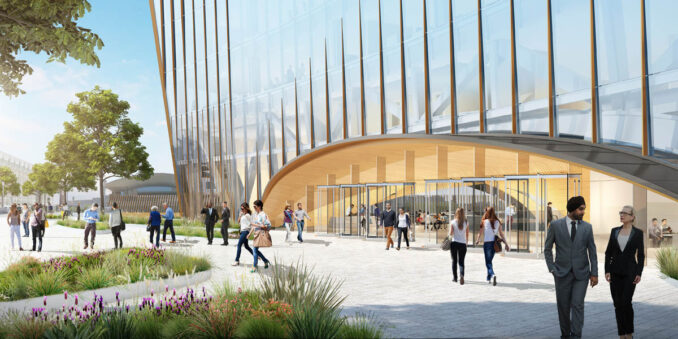
This landscape is designed to be viewed not just from four sides but also from below and above. With the Interstate 90 highway located immediately below, a suspended landscape, “The Landing,” acts as a gateway into the Seaport District. When viewed from above from the multiple buildings surrounding the site, the bold shapes and forms of the landscape emphasize the push and pull of the building’s architectural form. Finally, from within, key views and gateways are created through strategic planting and carefully positioned overlooks to create an experience that is always moving and evolving with the seasons — designed to be equally striking in the dead of winter as in the vibrant bloom of summer.
There are spaces to eat, sit and relax under the trees, and gather within the landscape. The design approach deliberately provides a sense of enclosure to the south, sheltering people from the rushing whir of the I-90 highway. In contrast, the landscape falls away towards the north to emphasize the connection between interior and exterior environments. When viewed from the waterfront, the tiered landscape of the access ramps up to The Landing conveys an alluring sense of depth and layering to the planting that draws visitors to the building’s front door.
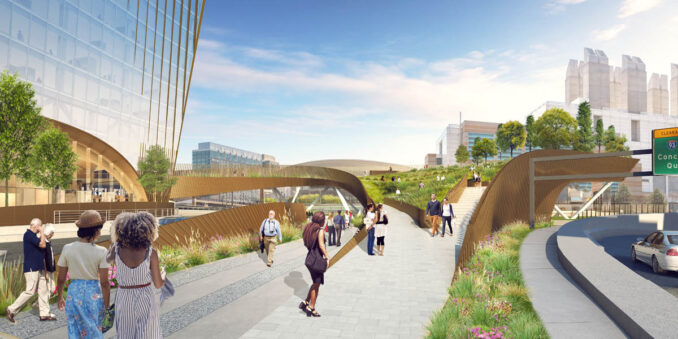
Planting Design
The planting palette at 10 World Trade is inspired by coastal New England ecology, with environments ranging from the coastal meadow at the base of The Landing, to coastal shrubland and upland meadows, up to the coastal bluff landscape ubiquitous throughout the Northeastern United States.
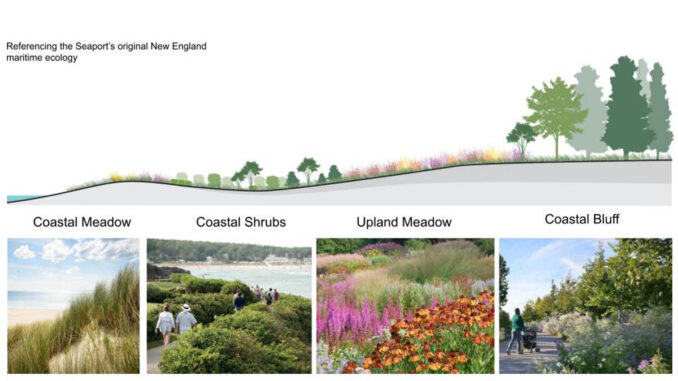
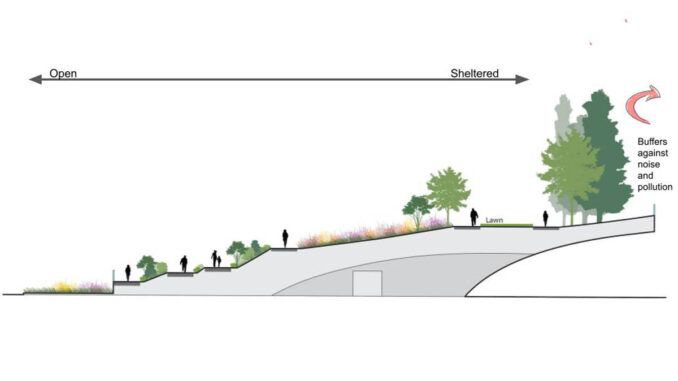
Thoughtful placement of trees and understory plantings create a series of gateways and thresholds that narrow and widen as pedestrians move through the space, defining overlooks and niches while offering views towards the Boston Convention and Exhibition Center of the lower level landscape below. These carefully cultivated moments aim to create sequential experiences that tie the building’s interior to the outdoors and weave the new landscape into the site’s wider context.
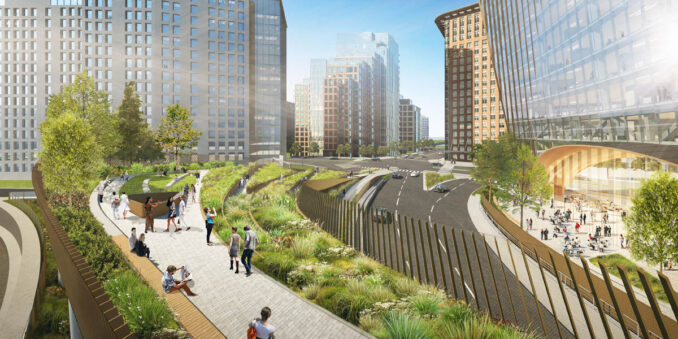
An Integrated Design Process
Sasaki’s architectural and landscape teams collaborated to create a seamless relationship between the interior and exterior public spaces. Weekly design charrettes where the building and landscape discussion were attended by the entire design team, ensuring all team members had a thorough understanding of the design intent for both interior and exterior spaces. A willingness to collaborate and iterate resulted in a unified overall design vision, borrowing elements or views from one to strengthen the other and reinforcing that the space will be understood as a singular, unified experience. This unified approach was key when working through the project’s thoughtful focus on sustainability with the accreditation of LEED, WELL, and being one of the first SITES accredited projects in Boston.
Today, in the wake of the global pandemic that has defined the world’s collective memory of 2020 and early 2021, we have a greater appreciation of how the spaces we inhabit impact our wellbeing. Our experience of the COVID-19 crisis, where time spent outdoors has become almost sacred, reaffirmed the need for robust networks of public parks and open spaces throughout our urban environments. These provide moments of respite, connection, and recreation. But equally as important are the transitional spaces that we move through daily. The interplay between connective landscapes, buildings, and open space greatly impacts our collective capacity to enjoy our cities.
By designing projects like 10 World Trade, we uncover new opportunities for landscape architecture and architecture to work in tandem to utilize interstitial spaces and challenging parcels to clever advantage. As the remaining parcels throughout city centers are built up, we must remember the lessons of this time to prioritize the public realm in all of its forms. By continuing to design collaboratively and innovatively, landscape architects and allied professionals can create spaces that are at once bold and intriguing but also accessible, equitable, and welcoming.
10 Trade Center
Location: Boston, Massachusetts, USA
Client: Boston Global Investors
Landscape Architect: Sasaki (also Architecture and Interior Design Services)
Text: Philip Dugdale, Sasaki Senior Associate, landscape designer
Images: Sasaki

